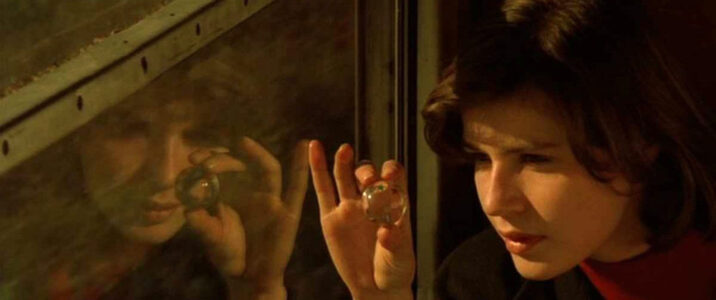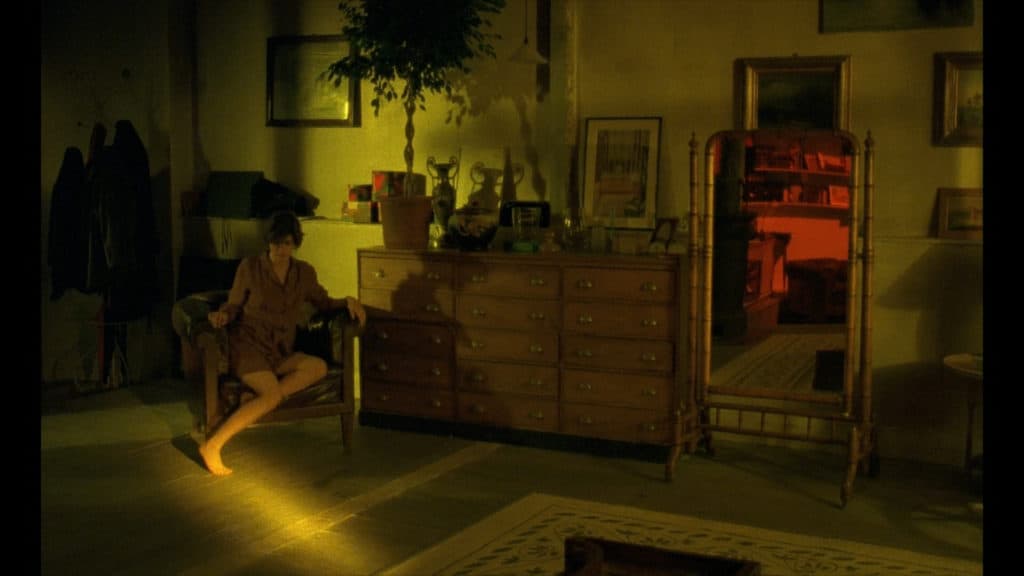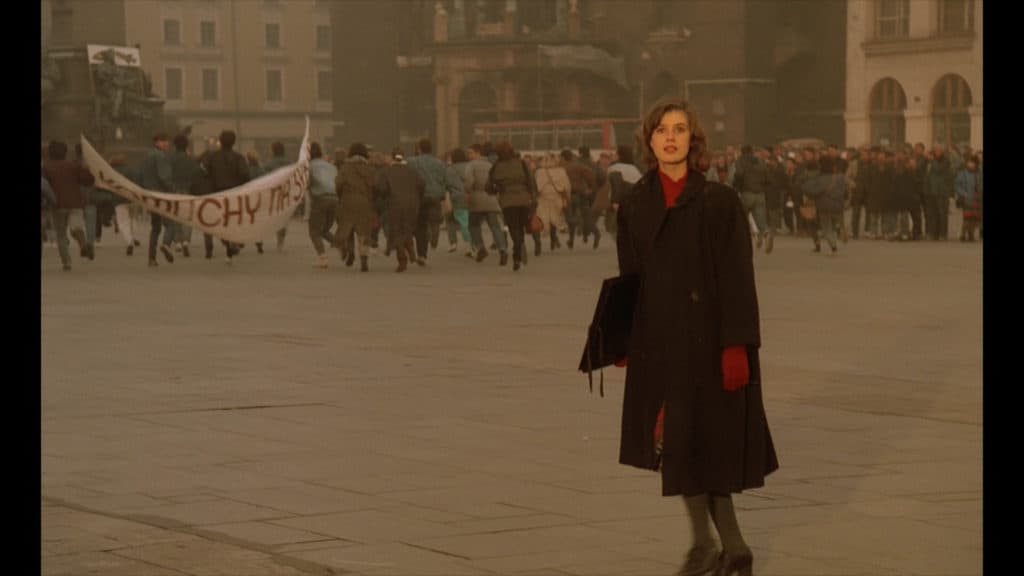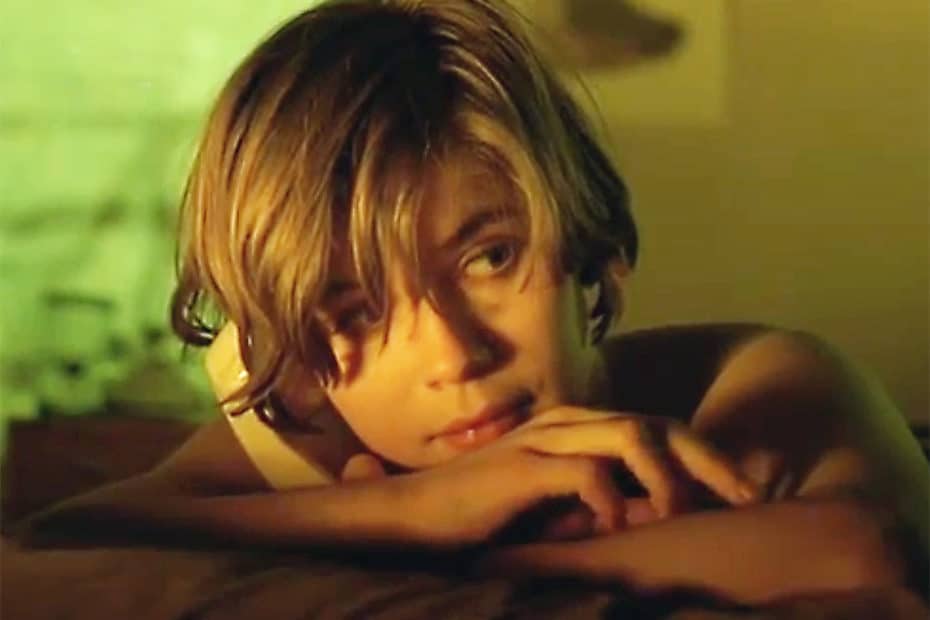La Double Vie de Véronique or Podwójne życie Weroniki, as it’s called with an untranslatable pun, was released on this day, 30 years ago. It was the first film by Krzysztof Kieslowśki that was co-produced outside Poland. The success of the Decalogue had made the director an art-house superstar, so it was no surprise that French producers would be interested in him. The film takes place in Poland and France, where we meet Weronika and Véronique, respectively. They are both played by Irène Jacob, and the similarities don’t end there. Weronika sings, whereas Véronique teaches music. They leave their small cities for a big one, and each suffers from a heart condition.
The first part of the diptych is largely set in Kraków. That’s where Weronika goes to spend time with her aunt, who is ill (The wonderful Halina Gryglaszewska). She eventually ends up in a choir where Kieslowski regular Aleksander Bardini portrays the conductor. In France, Véronique works as a music teacher. She has stopped singing to her teacher’s chagrin. The music by Van den Budenmayer1 A fictitious Dutch composer invented by Kieslowski and his co-writer Krzysztof Piesiewicz, which she analyses in a class, we’ve already heard Weronika sing during a concert. She gets entangled with a puppeteer she met during a performance attended by her class. He will try to pull her strings in more ways than one.

The Two sides of La Double Vie de Véronique
I’m not going to divulge more of the plot(s). Suffice it to say that the script is exceptionally well written, and even though the connections between the two women are numerous, they never feel forced. Some of the connections are obvious, while others are subtle. This is a film that not only merits but amply rewards multiple viewings. The characters are portrayed as flawed human beings. There was a time during the making of the film when Kieslowski felt that Véronique was a bit too angelic. That is why he added the section about her lying about a sexual relationship to help a friend. Irène Jacob, who was fairly unknown at the time, is perfect in the two roles.

The film is strongly metaphysical, verging on the supernatural. An essential factor in achieving this is the cinematography by Sławomir Idziak. He and Kieslowśki already collaborated in A Short Film About Killing (Krótki film o zabijaniu 1988), where he experimented with weird angles and numerous filters to achieve an eerie effect. Here, the aim is to conjure a transcendental experience. It works wonders in several sequences. The scene where Weronika looks at the landscape through a rubber ball is one of the more straightforward examples. The lensing is perfectly balanced. The touristy shots of Western Europe that would plague the later Colour trilogy are nowhere to be found. A glorious example is a central scene in Kraków.

The sequence in question is shot in one of the most beautiful squares in Europe, Rynek Główny, A place that would handily lend itself to cosmetic, beautiful shots. Instead, the focus of the sequence is something else entirely. Compared to the postcard views of Paris in Trois Couleurs: Bleu (1993), complete with the Mouffetardisation of the Rue Mouffetard area, the contrast couldn’t be sharper. Trois Couleurs: Blanc (1994) suffers from similar problems, but luckily, the plot quickly moves to Poland. In Vèronique, the balance is kept until the very end. At least, that was the case with the version screened in Europe. In the US, Miramax mogul Harvey Weinstein asked for an alternative ending, which Kieslowski agreed to.
In my mind, La Double Vie de Véronique is one of the highlights of Kieslowśki’s career. The subsequent Colour trilogy was a significant disappointment artistically, even though they were very successful commercially. The White one was the strongest of the three, but it was still a mere shadow of works like No End (Bez Konca 1985), The Decalogue (Dekalog 1989) and Véronique. The film won three awards at the Cannes Film Festival and has aged far better than certain other films in that year’s edition. It shows the director at the height of his powers.


Hello,
Thank you for your website ! I have seen i don’t how many times the Double life of Veronique (it seems to me the magic of Kieslowski is making visual puzzles which require million times of rewind !),but a question still remains, maybe you guys have an idea or we could discuss ? There is a woman wearing hat and a little bit scary air who appears two times but two crucial times in this film. First time she is one of them sitting below in the audience when Veronique of Poland dies on stage, second time near the end of the film she is passed by Veronique of France in the street. Why the same woman almost in the same costume ? I have dissolved all the puzzles of the film except this one.
Best regards,
Hello Jane,
Thanks for your comment and apologies for the late reply. I’m not sure I have any smart answer to that one. I always figured it was just the same woman who was startled by seeing yet another Weronika. She seemed resentful towards her in Poland if I remember correctly.